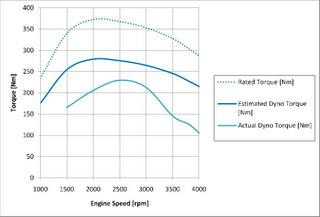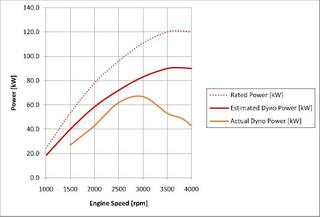Have you heard the old story about lies, damned lies and dyno results

. Seriously, chassis dynamometer results are notoriously difficult to interpret in an absolute fashion, because they are subject to many tuning parameters and are sensitive to operator technique. The basic problem is that the manufacturer rates the power and torque of the engine alone (measured at the flywheel), while the chassis dynamometer measures the engine power and torque as installed in a vehicle, driving the transmission, transfer box, final drives and wheels. Various techniques and assumptions are used to attempt to back-calculate the flywheel power and torque from the figures measured at the wheels.
The engine rating will have been determined by the manufacturer according to some or other engine rating standard and will be applicable to a certain set of ambient conditions (temperature and pressure), while the chassis dynamometer test is carried out at whatever ambient conditions exist on the day of the test. More calculations are then done to try to work back to what the engine rating would have been under the standard conditions (if known).
Taking all of this into consideration, the most appropriate use of a chassis dynamometer is to do comparative work, i.e. before and after runs (hopefully under the same ambient conditions) to determine whether some or other engine repair or modification has improved matters or not.
One should also bear in mind that there could quite easily be a power/torque output difference of 10% between two brand new engines, straight from the assembly plant, due to the different ways that manufacturing tolerances stack up.
Having said all that, let's assume that the chassis dynamometer results that you posted are believable. Now the rating of the 4M41 motor (3.2 DiD) is said to be 121kW at 3800 rpm and 373 Nm at 2000 rpm. I am not sure against which standard this rating was determined, but let's assume that is a nett, engine dynamometer rating (i.e. the engine should deliver this rated power when powering all necessary ancillaries (water pump, cooling fan, etc.) and while equipped with an intake and exhaust system representative of those in the Gen 3 Pajero.
The combined drivetrain losses (e.g. losses in the transmission, transfer box, differentials, propshafts, at tyre-wheel interface) in a four wheel drive vehicle can easily be around 25%. Let's assume this is the case for the Pajero. This would seem to indicate that the maximum power available at the wheels should be just under 91 kW and the maximum torque should be just below 280 Nm, both still at the same engine speeds as before.
Let's look at it on a graph. I have plotted the rated torque curve, estimated chassis dynamometer torque curve (given assumed losses) and actual measured torque curve together:

- DiD Torque Curves
The torque curve does not seem as flat as it should be. It seems dead at low rpm and then peaks at an engine speed higher than it should. The torque drops off rapidly from this peak. In addition to the many issues discussed above, the differences may also be due to things like:
* dirty air filter element
* restriction in air intake (perhaps something like a sponge sealing strip that has been ingested)
* injector pump settings
* condition of injectors
* throttle pedal position sensor
I have done a similar thing for the power power curves:

- DiD Power Curves
On this graph the fact that the engine "runs out of breath" at higher speeds is quite clearly demonstrated. The fact that the power curve does not have the same smooth shape as the rated power curve could indicate that all is not as it should be (see comments above).
Also bear in mind that two of the cylinders might be low on compression (based on the compression test that was done, but also bearing in mind that it was a cold test and not a test at operating temperature,as specified by Mitsu).
I don't know if this helps. Perhaps it would be even more reliable to get some Gen 3 DiD owners close to the vehicle to drive it and comment? I would be careful to accept the vehicle until I am satisfied that all is well. There are plenty of fish in the sea?

